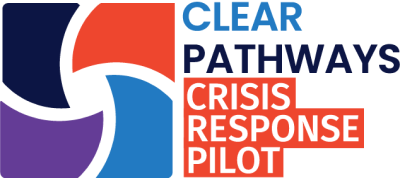Since 2022, Clear Pathways has developed and continuously refined an interoperability strategy. Interoperability formalizes the interconnection between systems beyond simple coordination to formal protocols, procedures, or agreements that allow for the transfer of calls between 9-1-1 and 9-8-8.[1]
The Clear Pathways interoperability strategy is based on the following:
- Interviews with 9-1-1 and 9-8-8 personnel,
- Ohio’s call center landscape, and
- Two core components derived from the SAFECOM Interoperability Continuum:
- governance (e.g., interagency collaboration, data governance, and formal role agreements); and
- standard operating procedures (SOPs) (e.g., step-by-step instructions for call-takers to identify and transfer eligible calls).
More information about the strategy can be found in Clear Pathways’
9-1-1/9-8-8 Interoperability Strategy brief, released in March 2025.
The Crisis Response Pilot
To test and improve this strategy, Clear Pathways conducted a 12-month Crisis Response Pilot, which focused on two objectives:
- Each of the 5 participating sites established a workgroup to facilitate regular collaboration among key 9-1-1 and 9-8-8 personnel in alignment with the strategy’s governance component.
- Each workgroup collaborated to co-develop criteria for transferring calls from 9-1-1 to 9-8-8 in alignment with the standard operating procedures component.
After the pilot, sites planned to formalize and implement procedures based on activities from the pilot process.
Crisis Response Pilot Workgroup Activities
During the pilot, workgroups engaged in four key activities:
- Building consensus, which included aligning goals within the sites, agreeing on collaborative practices, and developing work plans for interoperability.
- Understanding 9-1-1 and 9-8-8 system composition across the pilot sites, including exploring how calls are handled by both 9-1-1 and 9-8-8 systems, engaging in scenario exercises, and conducting site visits to observe 9-1-1 and 9-8-8 call centers.
- Analyzing and identifying call types, where efforts included determining the scope of behavioral health calls and their potential for transfer from 9-1-1 to 9-8-8 and selecting priority call types for transfer.
- Developing protocols, which included drafting agreements and developing decision trees. Preliminary findings from the evaluation report have identified next steps and opportunities for continued innovation.
Opportunities for Innovation in 9-1-1/9-8-8 Interoperability
Clear Pathways Interoperability Strategy
- Provide continued support and accountability
- Enhance tailored support and interoperability goals
- Prioritize peer learning and call center visits
- Provide guidance on when and how to include other partners
- Plan for a longer interoperability development time frame
Scaling 9-1-1/9-8-8 Interoperability
- Advance interoperability through leadership approval
- Expand funding and resources to support staff capacity
- Prioritize technology investments
- Improve behavioral health call identification by 9-1-1 staff, including revised emergency medical dispatch protocols for behavioral health assessment
- Develop a behavioral health interoperability continuum
Data Collection and Evaluation
- Improve behavioral health call coding by 9-1-1 staff, including assessing existing nature codes and their application during calls
- Expand interoperability metrics
- Introduce metrics early to prepare for call transfer implementation
- Examine the effectiveness of different types of 9-1-1 to 9-8-8 transfers
- Establish data linkages and enhance data collection across the crisis care continuum
Key Partners
This pilot was supported by Peg’s Foundation and the Pew Charitable Trusts and was conducted in collaboration with key partners, Mathematica and Dignity Best Practices.
References
[1] https://www.rand.org/pubs/research_reports/RRA3112-1.html


